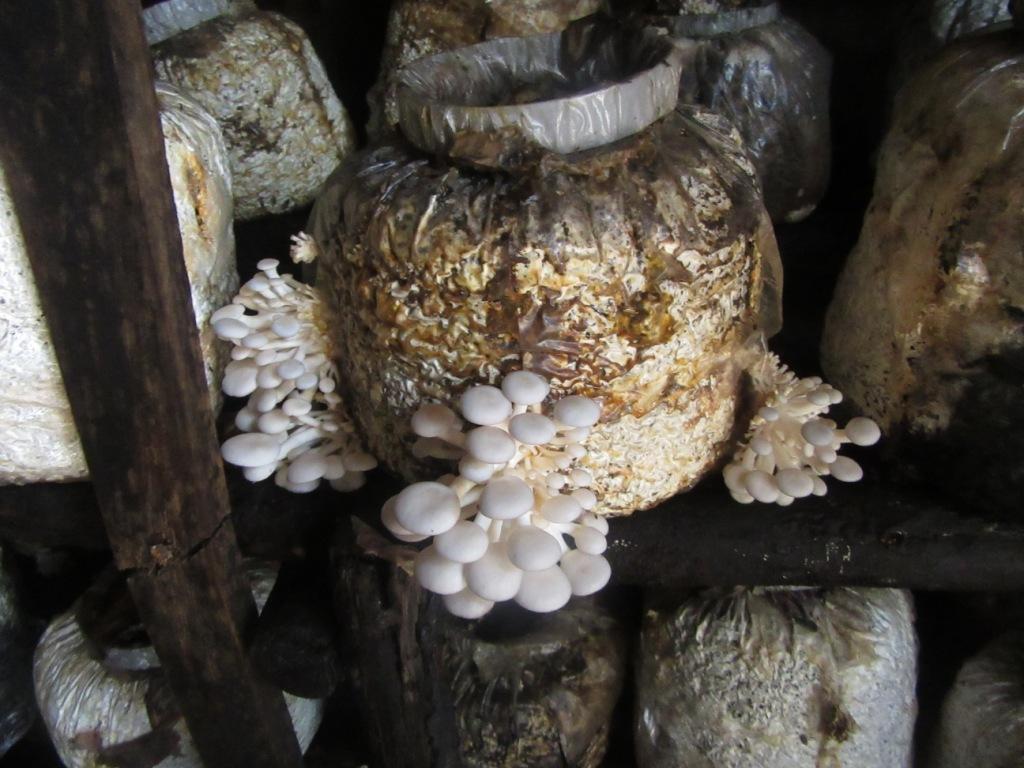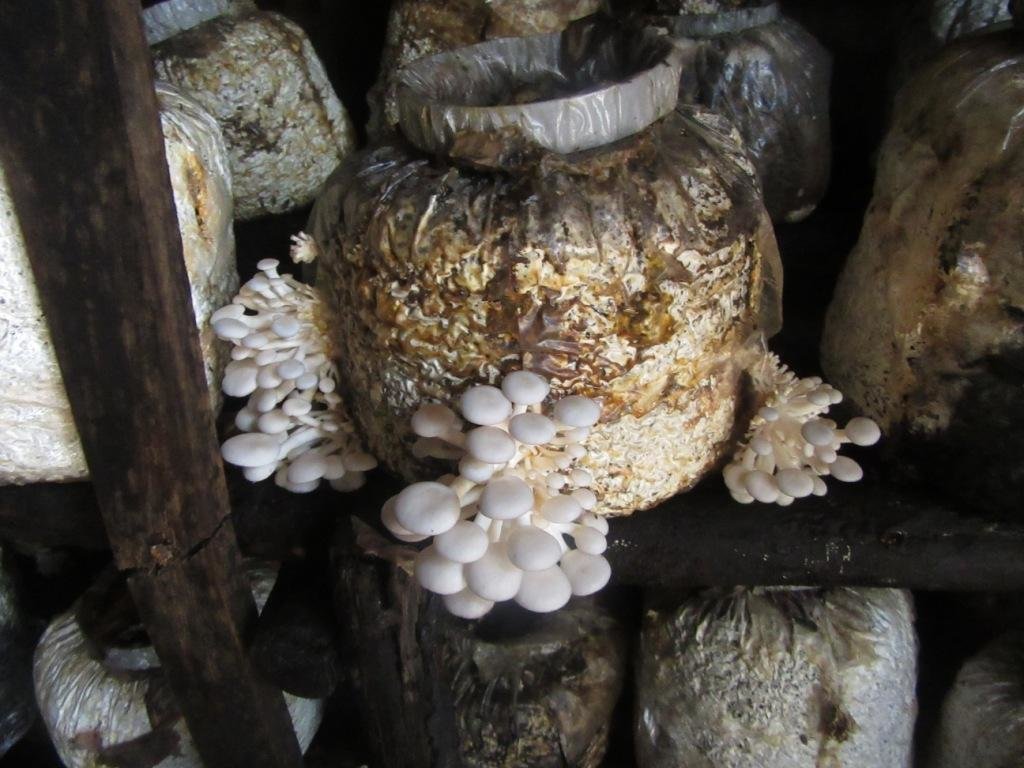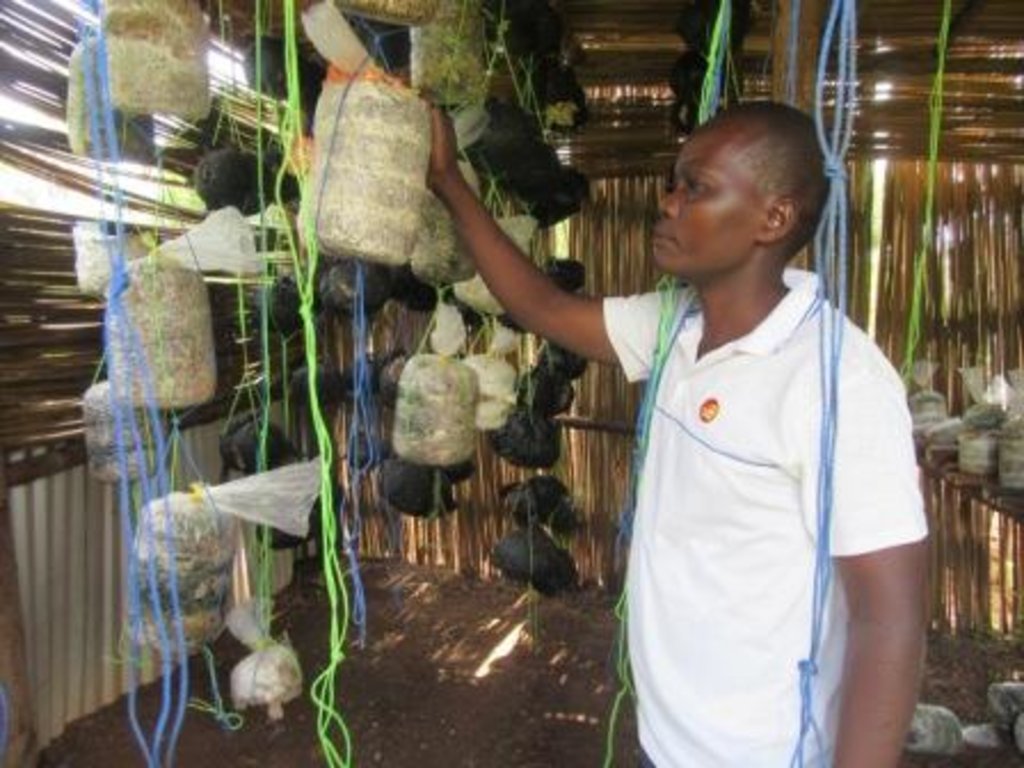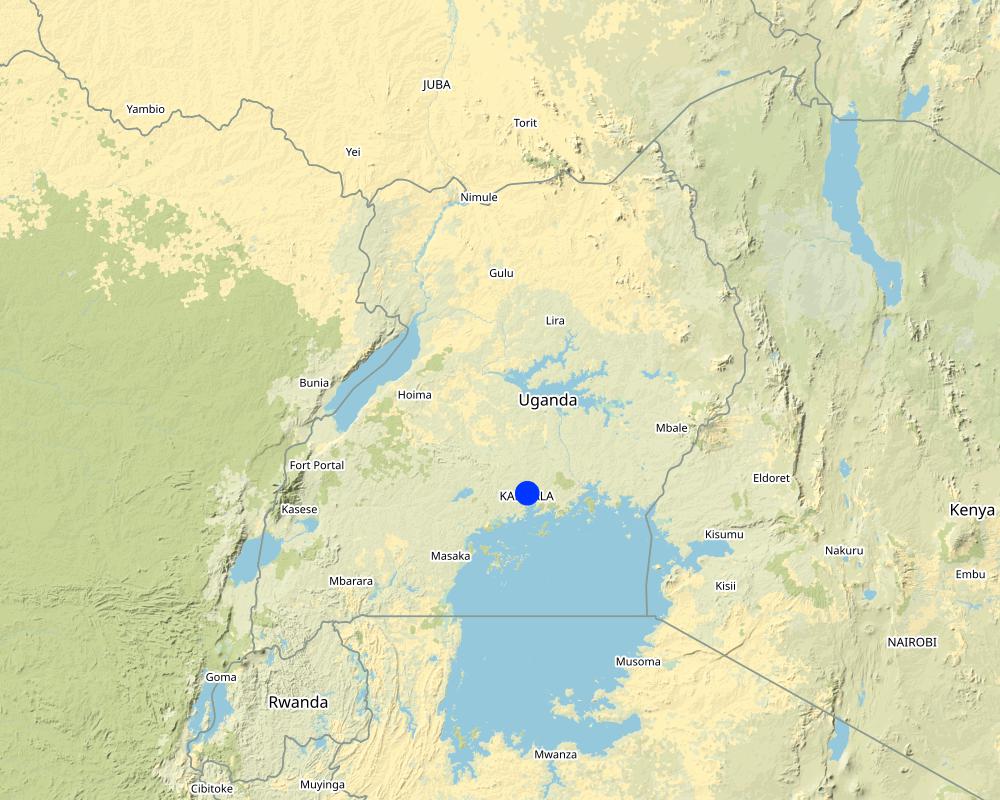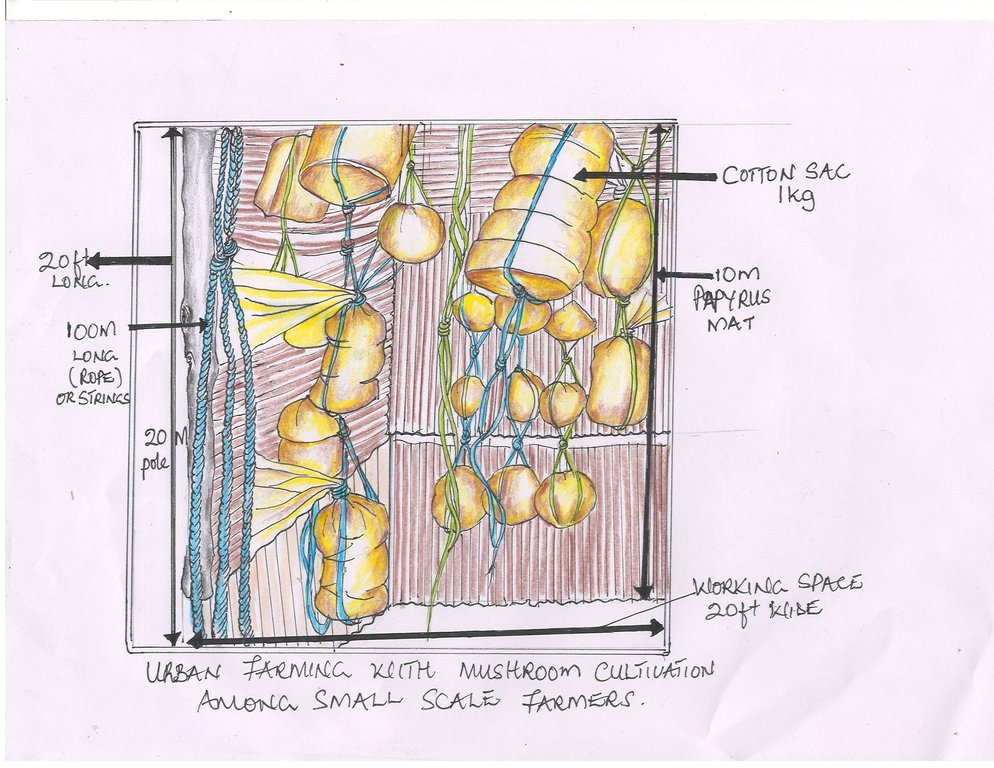Urban Farming with Mushroom Cultivation among Smallholder Farmers. [乌干达]
- 创建:
- 更新:
- 编制者: Sarah Babirye
- 编辑者: Jalia Namakula, Kamugisha Rick Nelson
- 审查者: Nicole Harari, Udo Höggel
Okulima obutiko
technologies_3450 - 乌干达
查看章节
全部展开 全部收起1. 一般信息
1.2 参与该技术评估和文件编制的资源人员和机构的联系方式
关键资源人
土地使用者:
Grace Komuhangi
0782524325
Kamyokya farmers group
Kamyokya, Kisenyi Kampala
乌干达
有助于对技术进行记录/评估的项目名称(如相关)
Scaling-up SLM practices by smallholder farmers (IFAD)有助于对技术进行记录/评估的机构名称(如相关)
National Agricultural Research Organisation (NARO) - 乌干达1.3 关于使用通过WOCAT记录的数据的条件
(现场)数据是什么时候汇编的?:
12/5/2017
编制者和关键资源人员接受有关使用通过WOCAT记录数据的条件。:
是
1.4 所述技术的可持续性声明
这里所描述的技术在土地退化方面是否存在问题,导致无法被认为是一种可持续的土地管理技术?:
否
注释:
The technology is not problematic with regard to land degradation.
2. SLM技术的说明
2.1 技术简介
技术定义:
Mushroom (agaricus bisporus) cultivation is one of the profitable technologies promoted by small and medium scale farmers in urban setting fetching good returns on investment within a period of 30 days with the aim of obtaining tremendous nutritional benefits, employment and additional income gained by both farmers and suppliers of raw materials thus supporting the local economy and contributing to subsistence food security.
2.2 技术的详细说明
说明:
Mushroom cultivation is a preferred and promoted technology by small and medium scale farmers with less land holdings. The technology has the portential to generate considerable nutritional benefits, employment and additional income which, in return, is invested in sustainable land management practices. To date, the demand for mushrooms increases as the result of a fast population growth having less income and food supply. Hence, a growing number of farmers adopt the mushroom production technology.
To establish such a technology, materials required include: cotton, a metallic drum (100 litres), a gunny bag of the size of 100kg, water, tarpuline, lime/maize brand, polyethene bags, banana leaf stock, cooking stove, firewood, mushroom seeds, tooth picks/nails and strings of approx. 100m length.
Listed below are the activities / procedures required for the establishment of a mushroom cultivation in a homestead.
-Water-soak the cotton into the drum and cover the drum with a gunny bag
-Remove the water out of the drum. The soaked cotton remains in the drum for around 2 hours
-Remove the soaked cotton on to a taurpline sheet and mix it with cultural lime/rice brand /maze brand that is placed on the taurpline
-Get black polythene bags and pack 1 kg of cotton into each polythene bag
-Place the banana leaf stock at the bottom of the drum and fill it with 20 litres of water
-Cut the gunny bag in the middle and cover the inside part of the drum to prevent burning of the cotton in the polythene bags while boiling
-Place the cotton in polythene bags into the drum and put the drum on the cooking stove to heat. The first line of polythene bags should be bent to prevent boiling water to enter the cotton
-Cover the drum tight with gunny bags
-Steam for around 2 hours
-Remove the firewood to cool until the next day
-Then remove the cooled cotton and place it on the tarpuline
-Buy mushroom seeds, smash the seeds (i.e, one pack of seeds mixes 2 gardens)
-Each kg of cotton mixed containing the mushroom seeds should be squeezed into the black polythene bags in a ball shape and tied on top
-Then get a tooth pick or a nail and pinch down 3 to 4 holes for air to come out
-Tie strings to the packed polythene bags and hang them for 14 days. (Strings enable sprouting on the gardens from all sides). Having moderate light, water needs to be applied twice a day or thrice in case of dry season during a period of 3 weeks
-After 7 days, the mushrooms start sprouting
-Leave the mushroom on the garden for 2-3 days before harvesting
-Once mushrooms are ripe, get a sharp knife and cut the stem carefully
On harvesting, the first week yields 8 Kg every second day, thereafter 3 kg of mushrooms every second day during the second month. Drums can be replaced every after 4 months so that the cost of maintenance is kept relatively low.
Mushrooms are a source of nutrients and proteins (Protein content, 3-7% when fresh and 25- 40% when dry). They are useful in preventing diseases and have medicinal values. Environmentally, the growing of mushrooms reduces pollution through bio-conservation and improves on crop production since harvested manure from the used mushroom ‘garden’ can be recycled as fertilizers for vegetable gardens at homes.
Despite the advantages, the technology faces various challenges: These include lack of a workplace (physical facility), lack of finance and skills on hygiene and sterilization, compost preparation, market challenges that include instability and decrease in sales prices of the products and inputs. Environmental factors like humidity, Ph, light and ventilation if not controlled may influence the growing process. Insects, diseases and animals due to the enclosed environment in which the mushrooms grow are a high risk. This may result in disease infestations like snails infestation.
However, maintenance costs of this technology are cheaper compared to establishment costs with minimum costs required for replacing worn out poles, replacing drums which can be at least every after 5 months.
2.3 技术照片
2.4 技术视频
位置:
Kamwokya, Kisenyi/Kampala
摄影师的名字:
Babirye Sarah
2.5 已应用该技术的、本评估所涵盖的国家/地区/地点
国家:
乌干达
区域/州/省:
Kampala
有关地点的进一步说明:
Kamwokya, Kisenyi
Map
×2.6 实施日期
如果不知道确切的年份,请说明大概的日期:
- 不到10年前(最近)
2.7 技术介绍
- A friend
注释(项目类型等):
Manure harvested from used up mushroom gardens is used as fertilizers in vegetable gardens.
3. SLM技术的分类
3.1 该技术的主要目的
- 改良生产
- 创造有益的经济影响
- 创造有益的社会影响
3.2 应用该技术的当前土地利用类型

定居点、基础设施
- 定居点、建筑物
3.3 有关土地利用的更多信息
注释:
The technology is practiced in buildings hence it doesn't require water from the rain or any irrigation source.
每年的生长季节数:
- 1
具体说明:
Once a month, so 12 seasons in a year
3.4 该技术所属的SLM组
- 家庭花园
3.5 技术传播
具体说明该技术的分布:
- 适用于特定场所/集中在较小区域
注释:
Mushroom are grown on a small area.
3.6 包含该技术的可持续土地管理措施

其它措施
注释:
Indoor mushroom cultivation. Residues from the gardens on which mushrooms grow can be recycled for fertilizers which can later be applied onto lands or homestead gardens to improve on soil fertility.
3.7 该技术强调的主要土地退化类型

其它
3.8 防止、减少或恢复土地退化
具体数量名该技术与土地退化有关的目标:
- 不适用
4. 技术规范、实施活动、投入和成本
4.1 该技术的技术图纸
4.2 技术规范/技术图纸说明
The technical drawing shows the mushroom technology with the following dimensions and inputs required for establishment; a working place (room) of 20 feet long *20 feet wide
One timber of 10 m long length, one tarpaulin of 20 m length *20 m width, strings/ropes of 100m length in total, 10m papyrus mats (2) , polythene bags (of 1 kg ), nails (2 kgs), one drum and 5 bags of cement and 20 gardens.
4.3 有关投入和成本计算的一般信息
具体说明成本和投入是如何计算的:
- 每个技术单元
指定单位:
A mushroom growing hut containing a number of mushroom gardens
指定体积、长度等(如果相关):
20feet long *20feet wide for a room where mushrooms are grown as shown in the picture
其它/国家货币(具体说明):
Uganda shillings
注明美元与当地货币的汇率(如相关):1美元=:
3600.0
注明雇用劳工的每日平均工资成本:
3000/= per day
4.4 技术建立活动
| 活动 | 措施类型 | 时间 | |
|---|---|---|---|
| 1. | Construction of a room of approximately 20*20feet | 结构性的 | Once through out the buisness enterprise |
| 2. | Buying equipments like drum,cotton,garden,jerricans,tarpauline,polythen bags | 结构性的 | Once through out the business enterprise |
| 3. | Hanging strings in the structure | 结构性的 | Once through out the busness enterprise |
注释:
Most of the activities for mushroom growing are cost effective. This is because these items and activities are done once on commencement.
4.5 技术建立所需要的费用和投入
| 对投入进行具体说明 | 单位 | 数量 | 单位成本 | 每项投入的总成本 | 土地使用者承担的成本% | |
|---|---|---|---|---|---|---|
| 劳动力 | Making a structure | Man day | 1.0 | 30000.0 | 30000.0 | 100.0 |
| 劳动力 | Hanging strings | Man day | 1.0 | 10000.0 | 10000.0 | 100.0 |
| 设备 | Drum | piece | 1.0 | 50000.0 | 50000.0 | 100.0 |
| 设备 | Cotton | piece | 2.0 | 25000.0 | 50000.0 | 100.0 |
| 设备 | Polythen bags | piece | 2.0 | 3000.0 | 6000.0 | 100.0 |
| 设备 | Jerricans | piece | 4.0 | 5000.0 | 20000.0 | 100.0 |
| 施工材料 | Strings | piece | 5.0 | 3000.0 | 15000.0 | 100.0 |
| 施工材料 | Poles | piece | 20.0 | 3000.0 | 60000.0 | 100.0 |
| 施工材料 | Nails | Kg | 3.0 | 5000.0 | 15000.0 | 100.0 |
| 施工材料 | Papyrus mats | piece | 10.0 | 7000.0 | 70000.0 | 100.0 |
| 其它 | Tarpuline | piece | 1.0 | 20000.0 | 20000.0 | 100.0 |
| 其它 | Seed packs | piece | 50.0 | 2000.0 | 100000.0 | 100.0 |
| 其它 | Maize brand | Kg | 10.0 | 1000.0 | 10000.0 | 100.0 |
| 其它 | Cultural lime | Kg | 1.0 | 15000.0 | 15000.0 | 100.0 |
| 其它 | Water | piece | 10.0 | 300.0 | 3000.0 | 100.0 |
| 其它 | Firewood | piece | 5.0 | 2000.0 | 10000.0 | 100.0 |
| 技术建立所需总成本 | 484000.0 | |||||
如果土地使用者负担的费用少于100%,请注明由谁负担其余费用:
National Agriculrueal Advisory Services (NAAD supported her with the drum).
注释:
The initial cost is relatively high for low income farmers although most acquire loans through farmer groups.
4.6 维护/经常性活动
| 活动 | 措施类型 | 时间/频率 | |
|---|---|---|---|
| 1. | Replace worn out poles | 管理 | Once a year |
| 2. | Replace old drums | 其它措施 | Once a year |
| 3. | Remove infestations by spraying snails | 农业学的 | Once a year |
| 4. | Cleaning in the growing room | 其它措施 | Once a year |
注释:
Most maintaince activities are not frequently made.
4.7 维护/经常性活动所需要的费用和投入(每年)
| 对投入进行具体说明 | 单位 | 数量 | 单位成本 | 每项投入的总成本 | 土地使用者承担的成本% | |
|---|---|---|---|---|---|---|
| 设备 | Replace old poles | piece | 10.0 | 3000.0 | 30000.0 | 100.0 |
| 设备 | Replace old drums | piece | 50000.0 | 1.0 | 50000.0 | 100.0 |
| 设备 | Spray snails | man hour | 3000.0 | 1.0 | 3000.0 | 100.0 |
| 设备 | Cleaning the room in which mushrooms grow on their gardens | man hour | 5000.0 | 1.0 | 5000.0 | 100.0 |
| 技术维护所需总成本 | 88000.0 | |||||
如果土地使用者负担的费用少于100%,请注明由谁负担其余费用:
All costs are met by the farmer.
注释:
Maintenance costs are less because items are replaced once in a year. This makes the technology cost-efficient.
5. 自然和人文环境
5.1 气候
年降雨量
- < 250毫米
- 251-500毫米
- 501-750毫米
- 751-1,000毫米
- 1,001-1,500毫米
- 1,501-2,000毫米
- 2,001-3,000毫米
- 3,001-4,000毫米
- > 4,000毫米
指定年平均降雨量(若已知),单位为mm:
1500.00
农业气候带
- 潮湿的
5.2 地形
平均坡度:
- 水平(0-2%)
- 缓降(3-5%)
- 平缓(6-10%)
- 滚坡(11-15%)
- 崎岖(16-30%)
- 陡峭(31-60%)
- 非常陡峭(>60%)
地形:
- 高原/平原
- 山脊
- 山坡
- 山地斜坡
- 麓坡
- 谷底
垂直分布带:
- 0-100 m a.s.l.
- 101-500 m a.s.l.
- 501-1,000 m a.s.l.
- 1,001-1,500 m a.s.l.
- 1,501-2,000 m a.s.l.
- 2,001-2,500 m a.s.l.
- 2,501-3,000 m a.s.l.
- 3,001-4,000 m a.s.l.
- > 4,000 m a.s.l.
说明该技术是否专门应用于:
- 不相关
5.3 土壤
平均土层深度:
- 非常浅(0-20厘米)
- 浅(21-50厘米)
- 中等深度(51-80厘米)
- 深(81-120厘米)
- 非常深(> 120厘米)
土壤质地(表土):
- 中粒(壤土、粉土)
土壤质地(地表以下> 20厘米):
- 中粒(壤土、粉土)
表土有机质:
- 中(1-3%)
5.4 水资源可用性和质量
地下水位表:
< 5米
地表水的可用性:
好
水质(未处理):
良好饮用水
水的盐度有问题吗?:
否
该区域正在发生洪水吗?:
否
5.5 生物多样性
物种多样性:
- 中等
栖息地多样性:
- 中等
5.6 应用该技术的土地使用者的特征
定栖或游牧:
- 定栖的
生产系统的市场定位:
- 混合(生计/商业
非农收入:
- 收入的10-50%
相对财富水平:
- 贫瘠
个人或集体:
- 个人/家庭
机械化水平:
- 手工作业
性别:
- 女人
土地使用者的年龄:
- 老年人
5.7 应用该技术的土地使用者拥有或租用的平均土地面积
- < 0.5 公顷
- 0.5-1 公顷
- 1-2 公顷
- 2-5公顷
- 5-15公顷
- 15-50公顷
- 50-100公顷
- 100-500公顷
- 500-1,000公顷
- 1,000-10,000公顷
- > 10,000公顷
这被认为是小规模、中规模还是大规模的(参照当地实际情况)?:
- 小规模的
5.8 土地所有权、土地使用权和水使用权
土地所有权:
- 个人,未命名
土地使用权:
- 个人
用水权:
- 个人
5.9 进入服务和基础设施的通道
健康:
- 贫瘠
- 适度的
- 好
教育:
- 贫瘠
- 适度的
- 好
技术援助:
- 贫瘠
- 适度的
- 好
就业(例如非农):
- 贫瘠
- 适度的
- 好
市场:
- 贫瘠
- 适度的
- 好
能源:
- 贫瘠
- 适度的
- 好
道路和交通:
- 贫瘠
- 适度的
- 好
饮用水和卫生设施:
- 贫瘠
- 适度的
- 好
金融服务:
- 贫瘠
- 适度的
- 好
6. 影响和结论性说明
6.1 该技术的现场影响
社会经济效应
生产
作物生产
土地管理
收入和成本
收入来源的多样性
注释/具体说明:
She is now able to pay loans and facilitate the home.
社会文化影响
食品安全/自给自足
注释/具体说明:
She can now be able to pay loans and facilitate home errands.
健康状况
注释/具体说明:
The mushrooms improve on the health conditions of human beings
社会经济弱势群体的情况
注释/具体说明:
There are many friendships created through the enterprise.
6.2 该技术的场外影响已经显现
有关影响评估的意见:
Not applicable to the technology
6.3 技术对渐变气候以及与气候相关的极端情况/灾害的暴露和敏感性(土地使用者认为的极端情况/灾害)
气候有关的极端情况(灾害)
生物灾害
| 该技术是如何应对的? | |
|---|---|
| 昆虫/蠕虫侵扰 | 适度 |
6.4 成本效益分析
技术收益与技术建立成本相比如何(从土地使用者的角度看)?
短期回报:
积极
长期回报:
积极
技术收益与技术维护成本/经常性成本相比如何(从土地使用者的角度看)?
短期回报:
积极
长期回报:
积极
注释:
There is high returns on investments.
6.5 技术采用
- 大于 50%
在所有采用这项技术的人当中,有多少人是自发地采用该技术,即未获得任何物质奖励/付款?:
- 90-100%
注释:
Most of the farmers support themselves.
6.6 适应
最近是否对该技术进行了修改以适应不断变化的条件?:
否
6.7 该技术的优点/长处/机会
| 土地使用者眼中的长处/优势/机会 |
|---|
| Creates job opportunities. |
| Increases income to farmers. |
| Creates socio relations among farmers. |
| 编制者或其他关键资源人员认为的长处/优势/机会 |
|---|
| It requires a small piece of land to set up the enterprise. |
| Promotes soil conservation through fertilizer collected from used up gardens. |
| Improves on nutritional values hence human welfare improved. |
6.8 技术的弱点/缺点/风险及其克服方法
| 土地使用者认为的弱点/缺点/风险 | 如何克服它们? |
|---|---|
| Sometimes mushrooms fail to grow if proper parameters are not maintained. | Maintaining proper parameters in the growing room. |
| Snails may lead to infestations of the mushroom cultivation. | Continuous spraying of gardens. |
| If a farmer lacks skills, mushroom growth may be hard. | By acquiring skills. |
| 编制者或其他关键资源人员认为的弱点/缺点/风险 | 如何克服它们? |
|---|---|
| Its a tedious work. | Engaging all family members. |
| Price fluctuation of the products. | Encouraging farmers to produce a lot of mushrooms. |
| The initial capital may be higher for a beginner. | Acquiring capital from farmers groups. |
7. 参考和链接
7.1 信息的方法/来源
- 实地考察、实地调查
1
- 与土地使用者的访谈
1
7.2 参考可用出版物
标题、作者、年份、ISBN:
Mushroom farming in Kenya: How you can make your first Ksh 1.000.000 in just 2 months.
可以从哪里获得?成本如何?
http://www.kuzabiashara.co.ke/blog/mushroom-millions/
7.3 链接到网络上可用的相关信息
标题/说明:
Mushroom cultivation in Uganda,Kenya,Tanzania and Rwanda
URL:
https://www.aboutuganda.com/uganda/agriculture/mushroom-growing
链接和模块
全部展开 全部收起链接
无链接
模块
无模块


